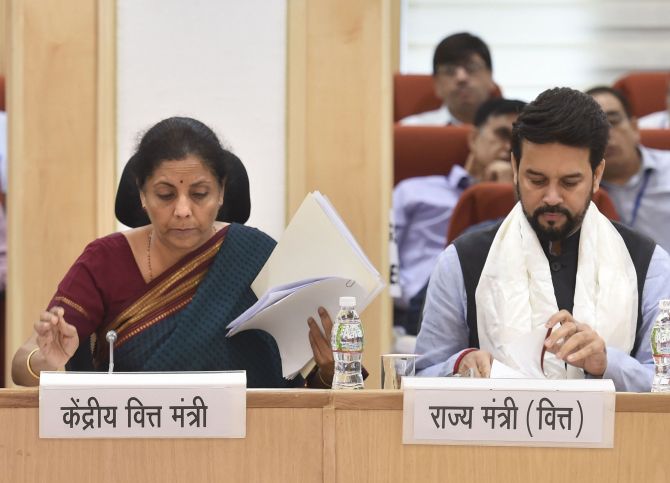 | « Back to article | Print this article |
If the protected growth in GST revenue is reduced to 10 per cent, the Centre would save more than Rs 25,000 crore in 2020-21 if none of the states show any revenue growth.
This would nearly amount to 0.1 per cent of the gross fiscal deficit and help the government in avoiding fiscal slippage to some extent in subsequent years.
Abhishek Waghmare reports.

The annual growth in Goods and Services Tax (GST) revenue promised to states under the GST law could be slashed to either 12 per cent or 10 per cent from the current promise of 14 per cent from next year, Business Standard has learnt.
However, this change is only under consideration and, if states agree to come on board, it could take place only in the next fiscal year, officials said on condition of anonymity.
But states would vehemently oppose such a proposal, it is being said.
In fact, sources said this idea was discussed during the presentation given by N K Singh, chairman of the 15th Finance Commission (15th FC), in the previous GST Council meeting.
“Doing such a change immediately is off the table, but in the long term, it would be considered,” said a senior government official.
The GST Council meeting, currently underway, is likely to discuss this.
Under the law, the Centre is bound to “protect” a 14 per cent growth in states’ GST revenues, and if shortfall arises, compensate it to the tune of the amount of shortfall, till June 2022.
The GST Council has introduced, and levied, compensation cess on certain items over and above the GST rate to compensate states.
If the protected growth in GST revenue is reduced to 10 per cent, the Centre would save more than Rs 25,000 crore in 2020-21 if none of the states show any revenue growth.
This would nearly amount to 0.1 per cent of the gross fiscal deficit of the government.
This would aid in avoiding fiscal slippage to some extent in subsequent years.
This number has been derived from the data presented by the finance ministry to Parliament.
In a way, while states would potentially lose slices of revenue “to be protected” if they fail to achieve 14 per cent growth in GST revenues themselves, the Centre would gain an amount equal to summation of slices for all states.
In the hypothetical case mentioned above, Maharashtra’s revenue will reduce the most (as it is the topper in revenue collection) by Rs 4,000 crore, and that of Karnataka and Tamil Nadu, by Rs 2,500 crore and Rs 2,000 crore, respectively.
If the guaranteed growth in revenue-to-be-protected is slashed to 12 per cent, the Centre would gain somewhat less than Rs 15,000 crore in the deal.
Experts said that such measures seem in line with the current subdued revenue trend for both the Centre as well as states.
“With slowing revenues, the Centre might not be able to guarantee 14 per cent growth every year from now on,” said Sacchidananda Mukherjee of National Institute of Public Finance and Policy (NIPFP).
Apart from states in the Northeast, which have a low share in overall national GST revenue, no other state has been able to clock a 14 per cent growth in GST revenue on its own.
There is a possibility that states would demand an extension in the compensation period beyond June 2022, and they would have to accept a slower growth in protected revenue in the bargain.
“The compensation cess and the revenue protection guarantee is the centripetal force that binds the states to the Centre in the GST Council.
"If the compensation and cess go away, what incentive would states have?” Mukherjee asked.